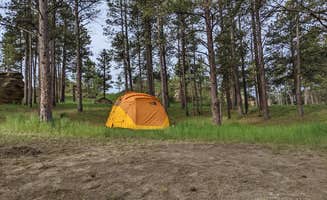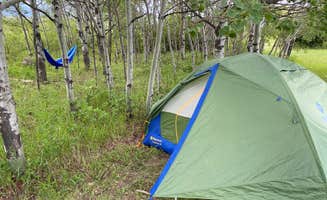Camping near Ekalaka centers on rugged, undeveloped sites spread across the southeastern Montana prairie and ponderosa pine forests. This remote region sits at approximately 3,400 feet elevation where summer temperatures regularly exceed 90°F and winter conditions can be severe with significant snowfall. Most campgrounds maintain primitive facilities with limited cell service that strengthens at higher elevations around the region.
What to do
Explore unique geology: Medicine Rocks State Park Campground features sandstone formations with centuries of carvings and inscriptions. "This is a pretty neat campground if you enjoy geology and some history... a fun place for kids because they can run around on the rocks and still stay in view of parents," notes Evan H., highlighting the educational value beyond just scenery.
Wildlife watching: Macnab Pond Campground provides access to a spring-fed pond that attracts various wildlife species. The pond area is "ADA accessible" according to Blaine P., making wildlife observation possible for visitors with mobility considerations.
Stargazing opportunities: The area's minimal light pollution creates exceptional night sky viewing conditions. At Medicine Rocks State Park, Daphne D. observed that "the night sky is very dark, though, so I'm sure it would be breathtaking on a clear night," suggesting optimal conditions for astronomical observation.
What campers like
Peaceful seclusion: The remote setting provides genuine solitude rarely found at more developed campgrounds. At Medicine Rocks, Mark J. appreciated that it's a "lovely spot if you want peace and tranquility, that sky at night is something else!" Many campsites feel private despite being within established campgrounds.
Natural shade: Lantis Spring Campground offers tree coverage that provides relief during hot summer months. Sydney reports, "There's a few groves of trees for shade and hammocks and while my group managed to find spots that stayed shaded all day, some of the sites are very sunny," indicating the importance of site selection.
Spring water access: Several campgrounds feature natural springs for water filtration. Sydney found at Lantis Spring that there's "a spring nearby for filtering water, established fire rings, and a very clean pit toilet," reducing the amount of water campers need to carry in.
What you should know
Water availability varies: Most campgrounds lack running water, requiring advance planning. At Medicine Rocks, Leslie B. notes there's a "water pump at entrance" but Mark J. cautions it has "no way of attaching a hose to fill a camper so I would bring water."
Road conditions: Access roads to remote sites remain unpaved but generally navigable without specialized vehicles during dry weather. Sydney observed that roads to Ekalaka Park Campground were "gravel but well maintained, didn't even have to put my vehicle into 4WD."
Limited maintenance: Some campgrounds receive minimal upkeep, affecting site quality. Tyler reports Ekalaka Park Campground has had challenges: "Unfortunately a forest fire bordering the campground has led to it being nearly unusable. Maintenance is minimal."
Tips for camping with families
Rock formations for exploration: Medicine Rocks provides natural play areas where children can safely explore. Evan H. observed it's "a fun place for kids because they can run around on the rocks and still stay in view of parents," making it ideal for families seeking outdoor activities.
Site selection considerations: Choose sites with adequate shade for comfort during hot summer days. Leslie B. notes that at Medicine Rocks, "Sites were numbered but it was sometimes hard to see where you should park. Sites were not really level," suggesting families bring leveling blocks.
Pack-in necessities: Wickham Gulch Campground and most other sites in the region require bringing all supplies as services are minimal. The limited facilities mean families should pack extra water, food, and entertainment options for children.
Tips from RVers
Leveling requirements: Bring stabilizing blocks as most sites have uneven terrain. Mark J. advises about Medicine Rocks: "Very basic sites and a little uneven so you will want blocks to level up."
Water fill strategy: RV campers should arrive with full water tanks as fill options are severely limited. Mark J. warns about Medicine Rocks' water pump: "There is water at the gate but it's a hand pump with no way of attaching a hose to fill a camper so I would bring water."
Size limitations: Many campgrounds cannot accommodate larger rigs due to narrow access roads and small site dimensions. Most sites work best with smaller trailers under 25 feet, as Mark J. successfully used a "22' trailer" at Medicine Rocks during peak season.



